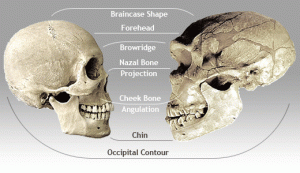This week in class we talked about how early humans used tools to hunt, butcher meat,and perform other tasks, and how archaeologists have been unearthing these tools as artifacts. I had previously read about the use of glue in early stone tools and was intrigued by it, so since we did not cover this thoroughly in class, I decided to do more research.
As it turns out, Neanderthals (Homo neanderthalensis or Homo sapiens neanderthalensis) used glue in their tools and were one of the first species to do so. The glue used by Neanderthals has been discovered in two different types. The first was made by retrieving and heating asphalt deposits, yielding a sticky substance that could be used to bind a spear tip made out of stone to a wooden shaft. This glue was used along with animal sinew or some other form of “string” used to tie the wood to the spear tip. A second type of glue was manufactured using an even more complex process. This glue was made by extracting pitch from birch bark. Through experimental methods, researchers have discovered that manufacture of this pitch would entail heating the bark to a temperature of higher than 650 degrees fahrenheit in an oxygen-free environment. The pitch has been discovered at archaeological sites in Königsaue, Germany; Inden-Altdorf, Germany; and Campitello, Italy. The substance was found near Neanderthal-style tools, implicating Neanderthals in the manufacture of this complex material. The sites date back from 40,000 to 200,000 years.
The implications of these finds are astonishing. Both of the types of “glue” yielded by Neanderthal manufacture qualify as “synthetic” materials, as heat was used to extract a substance that could not be harvested directly from the earth from another that did occur in nature. Furthermore, the second process implicates that Neanderthals had some knowledge of chemical principles, as they had to not only create an environment with a very high temperature but one containing no oxygen, which would require a conscious effort to devise a method of excluding oxygen from said environment. This use of critical thinking skills is one that we would typically attribute to our species alone – yet these finds suggest that Neanderthals were doing it before modern humans even existed, over 200,000 years ago. This evidence is key in the debate on whether Neanderthals should be classified as a subspecies of Homo Sapiens (our species). Interbreeding is known to have occurred between the two species, and usually it is only possible for members of the same species to mate. However, there are still several key differences between the two. Perhaps this discovery that Neanderthals used similar synthetic processes to those present in the modern human archaeological record proves that Homo Sapiens Sapiens are not so different from them after all.
Sources:
http://www.pbs.org/wgbh/nova/evolution/defy-stereotypes.html
http://www.bradshawfoundation.com/origins/skulls/sapiens_neanderthal_comparison.gif
http://www.scientificamerican.com/article/fossil-reanalysis-pushes/
http://www.ncbi.nlm.nih.gov/pmc/articles/PMC22133/
http://humanorigins.si.edu/evidence/genetics/ancient-dna-and-neanderthals/interbreeding
Additional Reading:



I’m not sure why the popular notion of past peoples is always that they were not as smart as us. Few of us would survive without our air conditioning, heat, hot water, grocery stores, cars, etc. That humans lived in the elements and off the land without these things means they were very smart.
I am most curious about the “experimental methods” used by researchers to determine how Neanderthals made the pitch. In order to figure out the process, the researchers inevitably had to attempt to recreate its various steps in a contemporary, lab setting. It seems to me like their investigation inevitably involved a great deal of trial and error, but I am interested in how exactly they carried this research out. What role did “modern” technology play in learning about ancient technologies. What does this reveal anything about the relationship between technology today and that of the past? Does this impact our understand of time?